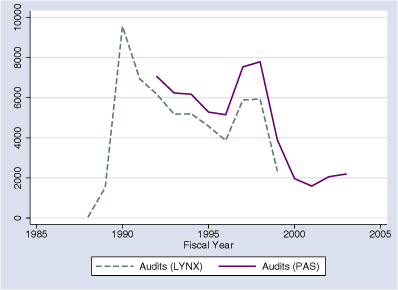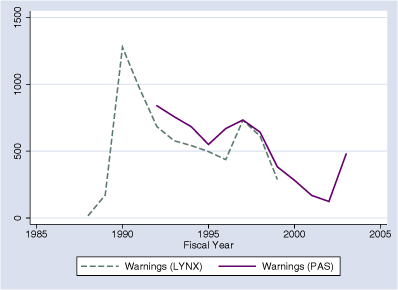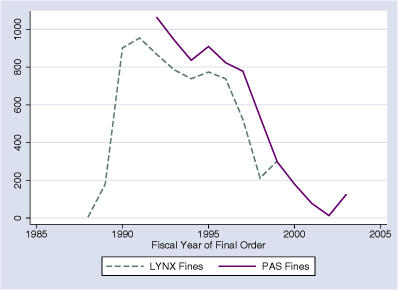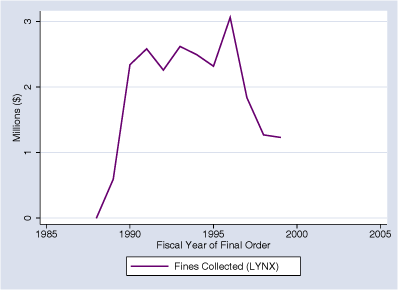The Declining Enforcement of Employer Sanctions
Prior to 1986, there was no federal law prohibiting the hiring or employment of unauthorized aliens. While employers might have found themselves with a sudden labor shortage caused by immigration raids, businesses employing immigrants without legal work authorization could not be cited for any violation of federal law. Rather, the 1952 law against "harboring" undocumented aliens contained the "Texas Proviso," which spelled out that employment was not considered "harboring" and was therefore legal.
In 1973, leaders from the American Federation of Labor — Congress of Industrial Organizations (AFL-CIO) and the National Association for the Advancement of Colored People (NAACP) convinced U.S. Representative Pete Rodino to sponsor a bill that would have made employing unauthorized immigrants illegal. While the bill died in Congress, it marked the beginning of a lengthy and contentious debate.
Out of this debate, the Immigration Reform and Control Act of 1986 (IRCA) was born. IRCA included employer sanctions provisions that made the knowing hiring or employment of unauthorized immigrants illegal. It also included a number of other provisions that made the reforms more palatable to groups favoring a more open immigration policy.
Key among these were a major legalization (or amnesty) program, the granting of legal status to unauthorized immigrants who had lived in the U.S. since 1982, a Special Agricultural Workers (SAW) program offering legal status to workers who had worked for a specified period in agriculture, as well as a revamped guest worker (temporary worker) programs.
The law also addressed concerns that employer sanctions might cause increased discrimination against legal immigrants and "foreign-appearing" U.S. citizens with provisions providing new protections from national origin and citizenship discrimination.
Research Findings
While Congress debated the immigration reforms that were to become IRCA, it directed the General Accounting Office (now called the Government Accountability Office - GAO) to conduct research on other countries' employer sanctions laws and how they were enforced.
In 1982, the GAO responded with a report concluding that, in the 19 countries surveyed, sanctions were largely ineffective for two reasons: employers either were able to evade responsibility for illegal employment or, once apprehended, were penalized too little to deter such acts; or the laws generally were not being effectively enforced because of strict legal constraints on investigations, noncommunication between government agencies, lack of enforcement resolve, and lack of personnel.
After the passage of IRCA, Congress required the GAO to produce annual reports on the implementation of employer sanctions during the first three years. However, the GAO did not understand this mandate to include investigating whether U.S. sanction laws were avoiding the problems it had identified in its 1982 report.
The reports documented that the Immigration and Naturalization Service (INS) was "satisfactorily" implementing sanctions, meaning that the agency had put procedures in place to educate employers about the law and identify and fine violators. The GAO did not report on whether the levels of enforcement were an effective deterrent to employing unauthorized immigrants.
This research agenda, however, was taken up by nongovernmental policy research organizations, especially the Urban Institute and Rand Corporation. In their 1990 report on the early implementation of IRCA, the Urban Institute's Michael Fix and Rand Corporation's Paul Hill found that the same issues of low levels of enforcement and limited intra- and inter-agency coordination, which had made for ineffective employer sanctions in the countries the GAO studied, threatened to make IRCA's sanctions provisions ineffective.
They warned that "[a] low level of enforcement activity could lead many employers to discount the possibility that violations will be detected and punished, thus weakening the deterrent effect."
These concerns were reiterated in chapters of a 1991 volume edited by Fix. For example, policy observers Demetrios Papademetriou, B. Lindsay Lowell, and Deborah Cobb-Clark warned that "the effectiveness of the effort to stem illegal immigration hinges on this nation's ability to devote sufficient resources to enforce all of the law's provisions."
In another chapter, policy analysts Robert Bach and Doris Meissner recommended an increase in the level of enforcement, arguing that "evidence is building that the early effort among employers to comply in response to publicity about the new law and wide-ranging INS contacts is dissolving into complacency as employers experience the low probability of an actual INS visit."
In 1994, evidence substantiating these concerns continued to build. The U.S. Commission for Immigration Reform raised concerns about declining resources for the enforcement of employer sanctions as well as other labor standards. Testifying before Congress, the GAO confirmed that funding and staffing for sanction enforcement, as well as numbers of investigations, had all declined since 1989.
Fifteen years have passed since the Urban Institute and Rand Corporation studies of employer sanctions' early implementation. However, there has been relatively little research on the levels and effectiveness of employer sanctions since the early 1990s.
Given concerns raised in these earlier studies, there are a number of questions relevant today: How has the enforcement of employer sanctions evolved over the last 10 to 15 years? Has renewed concern about unauthorized immigration reinvigorated the enforcement of employer sanctions? Or, has continued weak enforcement left sanctions an ineffective deterrent against unauthorized immigration?
Changes in Sanctions Enforcement over Time
To begin answering these questions, data on employer sanctions is necessary. In 2003, INS's investigations division, which was responsible for sanctions enforcement, was reorganized into Immigration and Customs Enforcement (ICE), part of the Department of Homeland Security (DHS) (other INS functions were split between various agencies within DHS). Drawing on two databases DHS currently maintains, the figures below show the time trends in INS sanctions enforcement activities.
Of the two databases, the Performance Analysis System (PAS) covers sanctions enforcement activities from fiscal years (FY) 1992 to 2003; LYNX data is publicly available for fiscal years 1987 to early 2000. While the LYNX system is missing some cases and therefore underestimates the true levels of enforcement, both sources show similar changes over time.
The figures show enforcement measures using both databases to show the trend for years covered by only one system. Presumably, the true level of enforcement for 1987 to 1992 (covered only by the LYNX system) is somewhat higher than indicated, but likely move more-or-less parallel to the trend shown.
Employer Audits
Of the millions of employers in the United States, Figure 1 shows the number audited each year by the immigration authorities (INS, later ICE). An employer may be selected at random for an audit, or an audit may proceed from a "lead" from the public or another agency, such as the Department of Labor (DOL). An audit involves the inspection of the employers' "I-9" forms, on which employers are required to certify they have examined documents for each employee establishing his/her identity and authorization to work in the United States.
|
|
||
|
Since FY 1990, when observers warned that low levels of enforcement threatened to undermine employer sanctions' deterrent effect, the number of audits per fiscal year dropped 77 percent from a peak of almost 10,000 to less than 2,200 in FY 2003. While audits jumped up from FY 1997 to FY 1998 and again from FY 2002 to FY 2003, the overall trend can only be described as a steep decline.
Warnings
Audited employers found not to be in compliance may receive a warning "for minor verification violations in those cases where the [Immigration and Naturalization] Service expects future compliance by the violator" (61 FR 52235). More serious violations, including charges of knowingly employing unauthorized immigrants, can result in the levying of fines.
Figure 2 shows the overall trend in the number of warnings issued by INS/ICE. The decrease is evident here as well, with a 62 percent decline from a peak of nearly 1,300 warnings in FY 1990 to less than 500 in FY 2003.
|
|
||
|
Fines
Employers found to be in serious violation of IRCA's employer sanctions provisions are issued a "Notice of Intent to Fine" (NIF). If employers do not appeal the NIF within 30 days or if they lose their appeal, a "Final Order" is issued detailing their violations and the fines imposed.
At this point, some employers enter into negotiations with the government and reach a settlement to pay less than the fines imposed by the Final Order. Note that some businesses dissolve or move upon being issued a NIF, and, in some such cases, no Final Order is served. Figure 3 shows the number of Final Orders. As in the other figures, we see a strong downward trend, dropping 82 percent from a peak of nearly 1,000 in FY 1991 to a total of 124 in FY 2003.
|
for FY 1988 to 2003 |
||
|
While all other measures show a fairly clear downward trend, the total dollar value of fines actually collected has been somewhat more stable throughout the early 1990s at around $2.5 million per year. As Figure 4 shows, it peaks at $3.1 million in FY 1996, and then declines in the latter part of the decade, dropping by more than half to $1.2 million in FY 1999.
|
for FY 1988 to 1999 |
||
|
The decrease in the number of cases resulting in fines means that, through the mid-1990s, the INS was increasingly successfully at imposing and collecting fines. However, even at the peak of $3.1 million in 1996, the total is relatively small — an average of about three cents for every paid employee in the United States.
To put this in perspective with other labor standards enforcement, California's Targeted Industries Partnership Program, a joint effort in 1997 between DOL and a number of state agencies in California, collected $1.25 million in penalties in California's garment industry alone. This amounted to an average of $8.31 for every employee in the California garment industry, in addition to a collection of $1.45 million in unpaid wages (about $9.64 per employee).
Declining Enforcement, Competing Missions
Throughout the 1990s and early 2000s, employer sanctions enforcement has been one of many missions competing for resources of staff and funding. Shifting priorities within the INS/ICE may explain the declining levels of sanction enforcement.
In 1994, the INS announced its southwest border strategy, which included the well-known "Operation Gatekeeper" in San Diego as well as a number of similar operations in other Border Patrol districts. By 1996, the INS had shifted Border Patrol agents previously assigned to interior enforcement (including employer sanctions) to border enforcement.
Then, in 1999, the INS adopted a new interior enforcement strategy that listed "block and remove employers' access to undocumented workers" as the last of five interior enforcement priorities. The strategy called for focusing resources on those cases with a "clear nexus between alien smuggling and the employment of unauthorized workers," which implies a loss of resources for investigations at worksites not implicated in alien smuggling (another of the five priorities).
Most recently, after the terrorist attacks of September 11, 2001, worksite enforcement took on a "National Security Focus," meaning that it was overwhelmingly directed at employers (especially subcontractors) placing workers at sites such as airports ("Operation Tarmac"), nuclear power plants ("Operation Glowworm"), and military bases.
Again, such a focus meant a loss of resources for enforcement at workplaces without national security significance, such as restaurants, hotels, garment factories, and farms. As one might imagine, after the reorganization of the INS into the Department of Homeland Security, worksite enforcement has continued to be heavily focused on national security.
Sanctions and Immigration Reform
After the GAO found in 1990 that IRCA's employer sanctions provisions had caused widespread employment discrimination, the NAACP joined with Latino civil rights groups in calling for sanctions' repeal.
In 2000, the AFL-CIO, which had also pushed for an employer sanctions bill in the 1970s, passed a resolution calling for their repeal, but not only because of employment discrimination. Labor leaders argued that some employers had used sanctions as a justification for calling in the immigration authorities on their own workforce in retaliation for organizing drives or efforts to assert other workplace rights.
The AFL-CIO's position is that the present system is "the worst of both worlds" in that the U.S. has almost negligible levels of enforcement against employers violating the laws, yet has allowed the potential for both discrimination and retaliation.
In contrast to the calls for sanctions' repeal, immigration reform bills currently before Congress propose to beef up employer sanctions enforcement with a new infusion of staff and funding (see related article that compares legislative proposals).
However, before investing in this approach, it would be worthwhile to examine the reasons for declining sanctions enforcement.
One likely reason has to do with the competing missions mentioned above. Until 1986, INS' enforcement efforts had always targeted aliens, that is, non-citizens. With IRCA, Congress called on the INS to enforce a law targeted at employers.
Yet individual members of Congress have interceded on behalf of their constituents in the business community when worksite enforcement disrupted business. The INS may have tried to escape this predicament by directing its enforcement resources back toward aliens, especially unauthorized aliens.
In fact, the only numerical goals the INS set for workplace enforcement in the post-IRCA period involved goals for arresting aliens. INS/ICE has never set performance targets for numbers of employers to be audited or numbers of fines to be issued.
Since 1999 INS/ICE has directed remaining employer sanctions enforcement resources against employers involved in migrant smuggling or other criminal activities, and employers at worksites vulnerable to terrorism. These employers are in a very poor position to complain that INS/ICE has been overzealous in their enforcement of employer sanctions.
Moving Forward
Clearly, the data show employer sanctions enforcement activities have dropped to levels that cannot reasonably be expected to create an effective deterrent to the employment of unauthorized immigrants.
The current system tolerates both the large-scale employment of the unauthorized and the discrimination and retaliation fostered by IRCA's employer sanctions provisions.
One way to make employer sanctions more effective in the future could be to grant the Department of Labor (DOL) a larger enforcement role. Currently, DOL is authorized to inspect I-9 forms (which verify and individual's employment eligibility) in the course of their investigations into compliance with other labor standards, but must then refer likely violations to ICE for possible further investigation.
Because DOL's historical enforcement role is directed toward employers, DOL could be expected to have greater autonomy to effectively pursue enforcement against businesses without political interference.
Also, because DOL has no mandate to enforce immigration laws directed against aliens, there would be no temptation to shift a greater share of enforcement resources toward that disenfranchised group. Rather, DOL has understood for some time that the effective enforcement of labor law requires that immigrants feel safe in calling to complain about labor standards violations.
However, moving enforcement responsibilities to DOL may not prove a panacea without other changes. The INS may have shifted resources away from sanctions enforcement because, under the current law, it is exceedingly difficult to prove an employer knowingly employed unauthorized immigrants.
Putting more investigators in the field, from either DOL or ICE, may only be of limited use if the deck is stacked against successful employer sanctions prosecutions.
Sources
American Federation of Labor - Congress of Industrial Organizations (AFL-CIO). 2000. "Immigration." Executive Council resolution. New Orleans, LA. Feburary 16. Available online.
California Department of Industrial Relations. 1998. "Targeted Industries Partnership Program Fifth Annual Report, 1997." San Francisco, CA. Available online.
Center for Immigration Studies. Employer Sanctions Database. Fix, Michael and Hill, Paul T. 1990. Enforcing Employer Sanctions. Santa Monica and Washington, DC: RAND Corporation and Urban Institute Press.
Fix, Michael (Ed.). 1991. The Paper Curtain: Employer Sanctions' Implementation, Impact and Reform. Santa Monica and Washington, DC: RAND Corporation and Urban Institute Press.
Gimpel, James G. and James R. Edwards, Jr. 1999. The Congressional Politics of Immigration Reform.
LeMay, Michael C. 1994. Anatomy of a Public Policy: The Reform of Contemporary American Immigration Law. Westport, CT: Praeger Publishers.
Washington Post. 1999. "INS Raids Follow Union Organizing; Aliens Say Law Is Being Misused." December 6: A3.
United States General Accounting Office. 1999. "Illegal Aliens: Significant Obstacles to Reducing Unauthorized Alien Employment Exist." Report to Congressional Committees, GAO/GGD-99-33. Washington, DC. Available online.
United States General Accounting Office. 1994. "Employer Sanctions: Comments on H.R. 3362 – Employer Sanctions Improvement Act." Testimony to Congressional Committees. GAO/T-GGD-94-189. Washington, DC. Available online.
United States General Accounting Office. 1990. "Immigration Reform: Employer Sanctions and the Question of Discrimination." Report to Congress, GAO/GGD-90-62. Washington, DC. Available online.
United States General Accounting Office. 1986. "Illegal Aliens: Information on Selected Countries' Employment Prohibition Laws." Briefing Report, GAO/GGD-86-17BR. Washington, DC.
United States General Accounting Office. 1982. "Information on the Enforcement of Laws regarding the Employment of Aliens in Selected Countries." GAO/GGD-82-86. Washington, DC.
United States Immigration and Naturalization Service. 1999. "INS' Southwest Border Strategy." Fact Sheet. Washington, DC. Available online.
United States Immigration and Naturalization Service. 1999. "Interior Enforcement Strategy." Backgrounder. Washington, DC. Available online.






